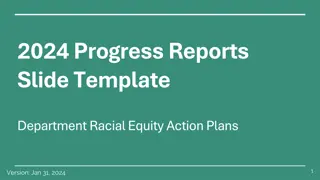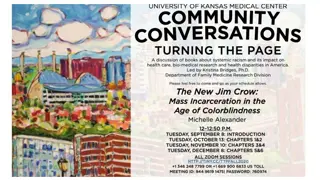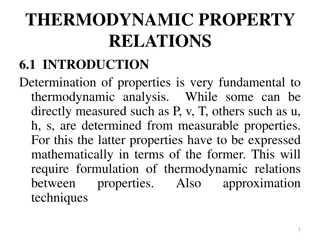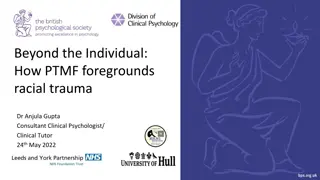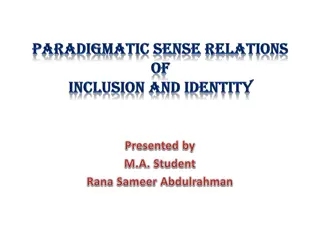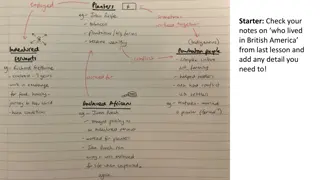Brazilian Ethno-racial Relations: A New Perspective
Brazil's demographic census history and evolution of racial categories, including insights from the recent PERLA data. Delve into the impacts of different classification systems on racial inequality and identity perception.
Download Presentation

Please find below an Image/Link to download the presentation.
The content on the website is provided AS IS for your information and personal use only. It may not be sold, licensed, or shared on other websites without obtaining consent from the author.If you encounter any issues during the download, it is possible that the publisher has removed the file from their server.
You are allowed to download the files provided on this website for personal or commercial use, subject to the condition that they are used lawfully. All files are the property of their respective owners.
The content on the website is provided AS IS for your information and personal use only. It may not be sold, licensed, or shared on other websites without obtaining consent from the author.
E N D
Presentation Transcript
HomeButton.png New Perspectives on Brazilian Ethno-racial Relations from PERLA-Brasil Graziella Mores Silva UFRJ Marcelo Paix o - UFRJ
HomeButton.png Brazil has a long tradition in collecting information over his population disaggregated by color or race Demographic Census: 1872, 1890, 1940, 1950, 1960, 1980, 1991, 2000, 2010
HomeButton.png Brazilian census categories use to be based on phenotypic features: skin color what is your color or race? (self-definition) Branco (White), Preto (Black), Pardo (Brown), Amarelos (Asian) Since 1991 Census the category Indigenous has been incorporated in the Brazilian census
HomeButton.png In the recent period, the Brazilian demographic and statistical system progressively have been incorporating the variable color or race Pnad, Pme, Sim, Sinasc, CadUnico, Rais, Caged, so on...
HomeButton.png Progressive increasing of the Black and Brown share in the Brazilian total residents 2012: Law 12,711 / 2012 1st Brazilian University has adopted Affirmative action for undergraduate access; Durban Conference Against Racism 2003: Creation of SEPPIR (Racial Equality Policies Ministry)
HomeButton.png The results of Perla data debated with this trajectory and several previous studies that discussed this matter Using official categories Accomplishing new researches with alternatives methods and questions
HomeButton.png So the main challenge of Perla Brazil research was how to bring new findings over the race categories ...And its effects over racial inequality: different classificatory systems use to lead different outcomes
HomeButton.png Our findings can be divided in three blocks: Outlook over different classificatory system using alternatives questions Perception about ethnic and racial identity and discrimination Racial inequality measures following the alternatives classificatory system
HomeButton.png Classificatory systems to measure color or race of the Brazilian population
HomeButton.png Interviewees' racial identification vs. Interviewers' categorization In this case our findings have converged with former studies that used similar classification method
HomeButton.png Percentage of negro interviewees, according to different indicators 59.4 60 54.9 50 39.7 40 31.4 30.8 30 25 19.3 18 20 15.2 6.9 10 5.6 0 Using different system to classify who could be considered Afrodescendant we found different possibilities. Officially Preto + Pardo in Brazil share almost 51% of the population
HomeButton.png Interviewers classification relying on IBGE categories and Color Palette It is worth to note the range of the palette color according with self- declaration. Convergences and differences
HomeButton.png Perception about national and ethnic identity Perception about discrimination and ethnic and racial advantages or disadvantages
HomeButton.png Perception of Differences across Ethnic-racial Groups
HomeButton.png Advantages and Disadvantages about being White, Black and Indigenous
HomeButton.png % of respondents who perceived discrimination (at least a few times) according to the context and by their IBGE racial identification 35.4% trated as suspicious on the street (only men) 21.5% 22.0% in job searching 15.2% 20.1% in the public space 8.2% 13.6% in contact with the police 5.9% black brown 13.0% in the workplace 8.3% white 12.8% in hospital/clinics 9.8% 12.5% in social gatherings/events 4.9% 2.9% inside their families 4.4% 0.00% 10.00% 20.00% 30.00% 40.00%
HomeButton.png Racial inequality following different classificatory system of ethnic and race definition
HomeButton.png Average years of Education by self-identification and classification by interviewer 9 8.5 8 7.5 7 6.5 6 5.5 5 White Brown Black White Brown Black Self-identification Classification by interviwer
HomeButton.png Education (average years of schooling) by classification of phenotype (hair and skin color according to the Color Palette) by interviewer 7.85 8.00 7.66 7.50 7.11 7.06 7.00 6.78 6.50 6.12 6.00 5.50 5.00
HomeButton.png Main finding is that the inequality is bigger when we use Color Palette So, if we compare this outcome with inequality coming from self-identification the first one was more intensive
HomeButton.png Maybe a good hypothesis to dialogue with recent dropping movement in the color and race inequality in Brazil. We can hint that at least in part this recent trend might be affected from the new identities of some part of Brazilian population: From White to Brown and from Brown to Black.
HomeButton.png Muchas gracias Muito obrigado!!!!


